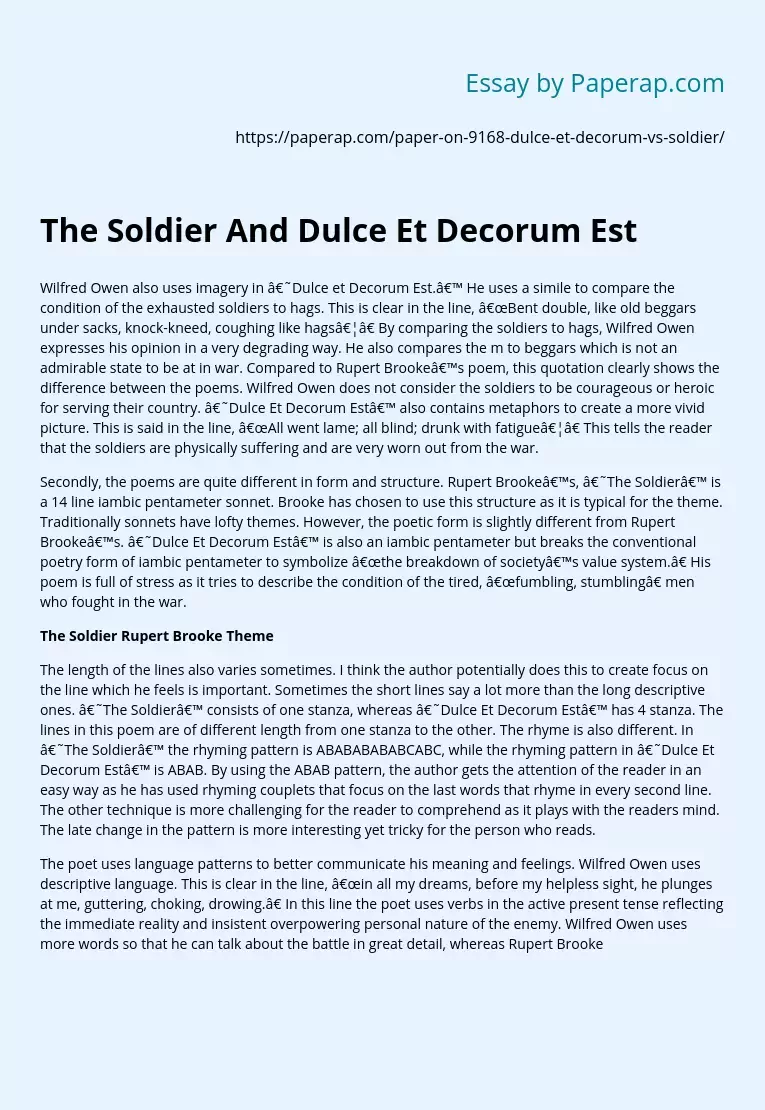The Soldier And Dulce Et Decorum Est
Wilfred Owen also uses imagery in ‘Dulce et Decorum Est.’ He uses a simile to compare the condition of the exhausted soldiers to hags. This is clear in the line, “Bent double, like old beggars under sacks, knock-kneed, coughing like hags…” By comparing the soldiers to hags, Wilfred Owen expresses his opinion in a very degrading way. He also compares the m to beggars which is not an admirable state to be at in war. Compared to Rupert Brooke’s poem, this quotation clearly shows the difference between the poems.
Wilfred Owen does not consider the soldiers to be courageous or heroic for serving their country. ‘Dulce Et Decorum Est’ also contains metaphors to create a more vivid picture. This is said in the line, “All went lame; all blind; drunk with fatigue…” This tells the reader that the soldiers are physically suffering and are very worn out from the war.
Secondly, the poems are quite different in form and structure.
Rupert Brooke’s, ‘The Soldier’ is a 14 line iambic pentameter sonnet. Brooke has chosen to use this structure as it is typical for the theme. Traditionally sonnets have lofty themes. However, the poetic form is slightly different from Rupert Brooke’s. ‘Dulce Et Decorum Est’ is also an iambic pentameter but breaks the conventional poetry form of iambic pentameter to symbolize “the breakdown of society’s value system.” His poem is full of stress as it tries to describe the condition of the tired, “fumbling, stumbling” men who fought in the war.
The Soldier Rupert Brooke Theme
The length of the lines also varies sometimes. I think the author potentially does this to create focus on the line which he feels is important. Sometimes the short lines say a lot more than the long descriptive ones. ‘The Soldier’ consists of one stanza, whereas ‘Dulce Et Decorum Est’ has 4 stanza. The lines in this poem are of different length from one stanza to the other. The rhyme is also different. In ‘The Soldier’ the rhyming pattern is ABABABABABCABC, while the rhyming pattern in ‘Dulce Et Decorum Est’ is ABAB. By using the ABAB pattern, the author gets the attention of the reader in an easy way as he has used rhyming couplets that focus on the last words that rhyme in every second line. The other technique is more challenging for the reader to comprehend as it plays with the readers mind. The late change in the pattern is more interesting yet tricky for the person who reads.
The poet uses language patterns to better communicate his meaning and feelings. Wilfred Owen uses descriptive language. This is clear in the line, “in all my dreams, before my helpless sight, he plunges at me, guttering, choking, drowing.” In this line the poet uses verbs in the active present tense reflecting the immediate reality and insistent overpowering personal nature of the enemy. Wilfred Owen uses more words so that he can talk about the battle in great detail, whereas Rupert Brooke can express himself within short sentences consisting of only a few words due to the totally different perspectives they have.
Rupert Brooke also writes, “A pulse in the eternal mind, no less. Gives somewhere back the thoughts by England given…” Here he describes his feelings in a very simplistic way. It is not as dramatic as Wilfred Owen’s way of expressing himself, but then again; the poems bring out two different perspectives of war. Rupert Brooke is very serious and patriotic whereas Wilfred Owen ironically states, “The old Lie: Dulce et Decorum Est Pro patria mor.” He believes the opposite because he has been exposed to the horrifying image of war. Rupert Brooke finds it heroic and brave to fight for ones country, while Wilfred Owen is trying to express the harsh reality of war.
In conclusion, it has been made clear that the poems are similar in one way yet completely different in the other. First of all, it is important to bear in mind that the message is different in the poems which affects the diction and poetic structure. Rupert Brooke leaves more to the imagination by not describing his every thought to the least detail. The rhyming patterns are unlike along with the form of the poems. The different forms, symbolizes their differences. They have two perspectives to war. Despite these differences, there is one element which they both have in common; their use of imagery. Both poems talk about war and are written around the same time which make them similar in subject.
The Soldier And Dulce Et Decorum Est. (2019, Dec 05). Retrieved from https://paperap.com/paper-on-9168-dulce-et-decorum-vs-soldier/

